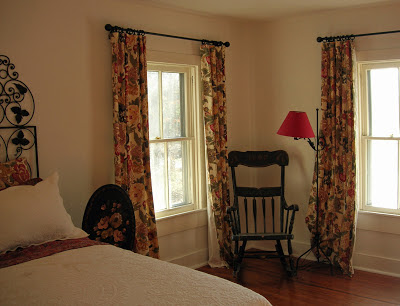I remodeled my kitchen in the city three years ago. It was such a fun process! I started with a red sink with a red faucet (there when I bought the condo), red walls (which I am totally responsible for - I was trying to match the sink), black and white appliances, a white Corian counter, white ceramic tile floors, and Ikea cabinets that were looking a little worn around the edges (literally).
I decided to keep the counter and the cabinet bases. I love white subway tile (I have it in my bathroom), but with white cabinets, it would have been too much white, so I went with a beautiful, green glass subway tile. Grey slate floors. A white sink. Stainless appliances. And new white Shaker-style cabinet doors and drawers, which I ordered online. I can't tell you how nervous I was about whether I had measured correctly, but it turned out perfectly. I installed all the doors and drawers myself. Three years later, I'm still in love.
Back then, I had a serious "thing" about matching. And I strongly believed that in kitchens, "kitcheny" artwork was required. So this is what I chose for a large wall that is to the right of the view in the above picture.
I should probably also show you the before view of this wall.
When I said it was red paint, I meant it!! (This was before paint+primer was invented, so it took me five, yes five, coats.) Removing the cabinet made such a huge difference. It made the kitchen look much bigger. I made up for lost storage with a large wire shelving unit from the Container Store.
I liked the artichoke art at first, but after a while, I got really tired of it. It was too matchy, and the neutral colors made it difficult to use bright colors elsewhere in the kitchen. I felt like it was sucking all of the life out of the kitchen.
When I decided that I needed to replace the artichokes, I thought I had the perfect solution - Orla Kiely's stem print fabric. I love the pattern and colors, and there was enough green in it to satisfy my urge for matching (still not cured), but it was clearly far far from boring and neutral. I soon discovered that you can't buy that fabric anywhere. So sad. I found this post on Making It Lovely when I was looking for the fabric online, and I totally feel Nicole's pain.
Then one day I was in a little housewares shop in Dupont Circle called Tabletop and made a very exciting discovery - Orla Kiely stem wrapping paper!! For just $4 a sheet. And the wrapping paper was reversible, with the large stem pattern on one side and the small pattern on the other. Sold!
My original idea was to cover the artichoke canvas with the paper. This was my first attempt at decoupage, and although I liked the idea of it, and the layout came out ok, it was a little rough looking, with bubbles and wrinkles, which are worse than they appear in the picture below.
So I scrapped this (I took it to my country house and hung it in the utility closet over the circuit breaker box - in that location, you don't really notice the imperfections) and started again. This time I decided to try a wall collage, with a smaller Orla Kiely decoupage of the large stem pattern as the main element and a framed piece of the small stem pattern as a complement. I then filled it in with other things I already had, and tada!

The other items are antique stained glass (I love love love - and collect - stained glass), an eggplant trivet, an "eat" trivet, and a framed color photocopy of a napkin I bought at Anthropologie. I also added some fun hooks from World Market (below right in the photo). The hanging files are from Ballard Designs from a few years back. They really help with mail and paper control. One is labeled "TO FILE" and the other "TO DO." By the way - I realize this is a crappy photo. I took several, with both camera and iPhone, and this is the best of the lot. I just may need a new camera. UPDATE: I just got a new DSLR camera!! Very exciting. I replaced the photo, but it's not much better than the original one. Oh well.
One more time, here's a close-up of the decoupaged Orla Kiely:
I started with an ugly wood "art" thing from Home Goods that was on sale in the clearance section (what?? I can't understand why no one wanted to buy it ... hee hee) for only $5.
Then I painted the sides with green Oops paint that I already had on hand and primed the top.
After that was dry, I put the Orla Kiely paper on top using 3 parts Elmers Glue to 1 part water (which here was 1 tablespoon of glue and 1 teaspoon of water) painted with a foam paintbrush onto the wood, onto the back of the paper, and onto the top of the paper. After that dried, I brushed on some matte polyurethane with a foam brush.
The final look is much more me. I'm considering getting a retro turquoise or orange clock to replace the existing one. What do you think?





















































